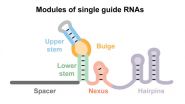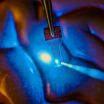(Press-News.org) (Philadelphia, PA) – Chest pain doesn't necessarily come from the heart. An estimated 200,000 Americans each year experience non-cardiac chest pain, which in addition to pain can involve painful swallowing, discomfort and anxiety. Non-cardiac chest pain can be frightening for patients and result in visits to the emergency room because the painful symptoms, while often originating in the esophagus, can mimic a heart attack. Current treatment — which includes pain modulators such as selective serotonin reuptake inhibitors (SSRI) — has a partial 40 to 50 percent response rate in alleviating symptoms.
New research authored by Temple University Hospital gastroenterologist Ron Schey, MD, FACG, suggests a novel approach to treating non-cardiac chest pain due to esophageal hypersensitivity. The treatment involves a drug called dronabinol, a cannabinoid receptor activator that has traditionally been used to treat nausea and vomiting in HIV patients and for cancer patients undergoing chemotherapy,
In a pilot study involving 13 patients with non-cardiac chest pain, Dr. Schey and his research team found that patients who were given 5 mg of dronabinol twice daily for four weeks fared better than patients who took a placebo, or dummy pill. Those getting dronabinol experienced improved pain tolerance and decreased frequency and intensity of chest pain. In addition, no significant adverse effects were reported.
"This novel study has promising findings in future treatment for these patients," said Dr. Schey, Associate Professor of Medicine at Temple University School of Medicine, who conducted the research while on staff at the University of Iowa Hospitals and Clinic, and analyzed the data at Temple along with Zubair Malik, MD, a first-year fellow in Temple's Division of Gastroenterology.
The pilot study, while encouraging, was very small and not designed to test dronabinol against current therapies for non-cardiac chest pain, so it is difficult to calculate how the drug performs in comparison to existing treatments, Dr. Schey said. He said dronabinol likely helps to diminish pain by activating cannabinoid receptors in the esophagus that decrease sensitivity.
The abstract was presented October 20 in Philadelphia at the Annual Scientific Meeting of the American College of Gastroenterology. The professional organization said it picked the Temple research to be among the "most newsworthy" studies presented at the conference because the findings have an impact on GI patient care.
Dr. Schey joined Temple in 2014; and his research interests include non-cardiac chest pain, GI motility disorders and esophageal disorders.
Dr. Schey said a larger scale study on the effects of dronabinol on non-cardiac chest pain will be initiated in the near future at Temple.
INFORMATION:
Editor's Note: Neither Dr. Schey nor any member of his immediate family has financial interest in AbbVie, the manufacturer of Marinol®, the brand name of dronabinol.
About Temple Health
Temple University Health System (TUHS) is a $1.4 billion academic health system dedicated to providing access to quality patient care and supporting excellence in medical education and research. The Health System consists of Temple University Hospital (TUH), ranked among the "Best Hospitals" in the region by U.S. News & World Report; TUH-Episcopal Campus; TUH-Northeastern Campus; Fox Chase Cancer Center, an NCI-designated comprehensive cancer center; Jeanes Hospital, a community-based hospital offering medical, surgical and emergency services; Temple Transport Team, a ground and air-ambulance company; and Temple Physicians, Inc., a network of community-based specialty and primary-care physician practices. TUHS is affiliated with Temple University School of Medicine.
Temple University School of Medicine (TUSM), established in 1901, is one of the nation's leading medical schools. Each year, the School of Medicine educates approximately 840 medical students and 140 graduate students. Based on its level of funding from the National Institutes of Health, Temple University School of Medicine is the second-highest ranked medical school in Philadelphia and the third-highest in the Commonwealth of Pennsylvania. According to U.S. News & World Report, TUSM is among the top 10 most applied-to medical schools in the nation.
Temple Health refers to the health, education and research activities carried out by the affiliates of Temple University Health System (TUHS) and by Temple University School of Medicine. TUHS neither provides nor controls the provision of health care. All health care is provided by its member organizations or independent health care providers affiliated with TUHS member organizations. Each TUHS member organization is owned and operated pursuant to its governing documents.
Customized genome editing – the ability to edit desired DNA sequences to add, delete, activate or suppress specific genes – has major potential for application in medicine, biotechnology, food and agriculture.
Now, in a paper published in Molecular Cell, North Carolina State University researchers and colleagues examine six key molecular elements that help drive this genome editing system, which is known as CRISPR-Cas.
NC State's Dr. Rodolphe Barrangou, an associate professor of food, bioprocessing and nutrition sciences, and Dr. Chase Beisel, an assistant ...
A longstanding question among scientists is whether evolution is predictable. A team of researchers from UC Santa Barbara may have found a preliminary answer. The genetic underpinnings of complex traits in cephalopods may in fact be predictable because they evolved in the same way in two distinct species of squid.
Last, year, UCSB professor Todd Oakley and then-Ph.D. student Sabrina Pankey profiled bioluminescent organs in two species of squid and found that while they evolved separately, they did so in a remarkably similar manner. Their findings are published today in ...
Research in recent years has shown that people associate specific facial traits with an individual's personality. For instance, people consistently rate faces that appear more feminine or that naturally appear happy as looking more trustworthy. In addition to trustworthiness, people also consistently associate competence, dominance, and friendliness with specific facial traits. According to an article published by Cell Press on October 21st in Trends in Cognitive Sciences, people rely on these subtle and arbitrary facial traits to make important decisions, from voting for ...
(SALT LAKE CITY)—Workers punching in for the graveyard shift may be better off not eating high-iron foods at night so they don't disrupt the circadian clock in their livers.
Disrupted circadian clocks, researchers believe, are the reason that shift workers experience higher incidences of type 2 diabetes, obesity and cancer. The body's primary circadian clock, which regulates sleep and eating, is in the brain. But other body tissues also have circadian clocks, including the liver, which regulates blood glucose levels.
In a new study in Diabetes online, University ...
DURHAM, N.H. –- Crewed missions to Mars remain an essential goal for NASA, but scientists are only now beginning to understand and characterize the radiation hazards that could make such ventures risky, concludes a new paper by University of New Hampshire scientists.
In a paper published online in the journal Space Weather, associate professor Nathan Schwadron of the UNH Institute for the Study of Earth, Oceans, and Space (EOS) and the department of physics says that due to a highly abnormal and extended lack of solar activity, the solar wind is exhibiting extremely ...
DURHAM, N.H. – Six percent of U.S. children and youth missed a day of school over the course of a year because they were the victim of violence or abuse at school. This was a major finding of a study on school safety by University of New Hampshire researchers published this month in the Journal of School Violence.
"This study really highlights the way school violence can interfere with learning," says lead author David Finkelhor, professor of sociology and director of the Crimes Against Children Research Center (CCRC) at UNH. "Too many kids are missing school ...
New research shows that a preservation technique known as sequential subnormothermic ex vivo liver perfusion (SNEVLP) prevents ischemic type biliary stricture following liver transplantation using grafts from donations after cardiac death (DCD). Findings published in Liver Transplantation, a journal of the American Association for the Study of Liver Diseases and the International Liver Transplantation Society, indicate that the preservation of DCD grafts using SNEVLP versus cold storage reduces bile duct and endothelial cell injury post transplantation.
The shortage ...
VIDEO:
Scientists at the US Department of Energy's Ames Laboratory modeled the 'passing probability' of molecules within the narrow pores of mesoporous nanoparticles. This understanding will help determine the optimal diameter...
Click here for more information.
Scientists at the U.S. Department of Energy's Ames Laboratory have developed deeper understanding of the ideal design for mesoporous nanoparticles used in catalytic reactions, such as hydrocarbon conversion to biofuels. ...
ATLANTA—Animal-assisted therapy can reduce symptoms of anxiety and loneliness among college students, according to researchers at Georgia State University, Idaho State University and Savannah College of Art and Design. Their findings are published in the latest issue of the Journal of Creativity in Mental Health.
The researchers provided animal-assisted therapy to 55 students in a group setting at a small arts college in the Southeast. They found a 60 percent decrease in self-reported anxiety and loneliness symptoms following animal-assisted therapy, in which a ...
MADISON, Wis. — Developing invisible implantable medical sensor arrays, a team of University of Wisconsin-Madison engineers has overcome a major technological hurdle in researchers' efforts to understand the brain.
The team described its technology, which has applications in fields ranging from neuroscience to cardiac care and even contact lenses, in the Oct. 20 issue of the online journal Nature Communications.
Neural researchers study, monitor or stimulate the brain using imaging techniques in conjunction with implantable sensors that allow them to continuously ...






